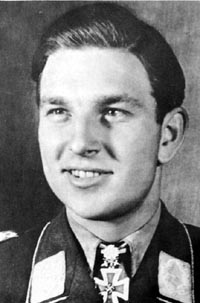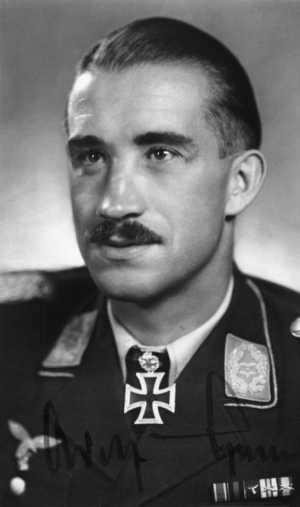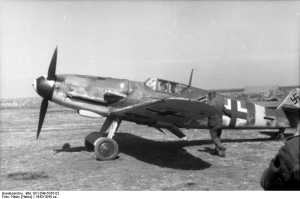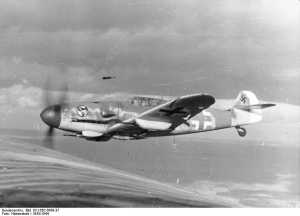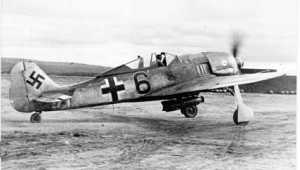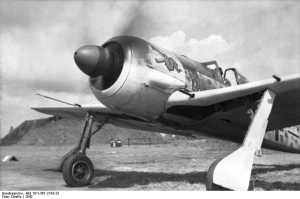WW2 German Airplanes and Aces
Luftwaffe Pilots, Fighter Planes, Bombers in WWII
By Stephen Sherman, Dec. 2008. Updated July 7, 2011.
During World War Two, Nazi Germany developed some of the most innovative aircraft, and the Luftwaffe pilots "experten," racked up huge scores, but the combined might of American and Russian power overwhelmed them. (Thank God!) Messerschmitt, Heinkel, Kurt Tank, and Junkers developed airplanes of all types - fighters, bombers, transports, and even jet fighters at the war's end. Pilots like Erich Hartmann, Adolph Galland, and Walter Nowotny won medals and shot down vast numbers of Allied planes. Here are their stories.
Early in the war, German aircraft technology was already well advanced, as Hitler had been re-arming for several years. The Luftwaffe had developed rapidly - at first, secretly, because of the limitations of the Versailles treaty, but from 1936 on, more openly, especially during the Spanish Civil War. Messerschmitt's Bf-109 was in production as early as 1937, while pilots like Galland and Molders flew combat missions over Spain.
Like all the combatants, Germany struggled to keep its aircraft up-to-date, constantly modifying them and introducing new variants. The Bf-109 evolved through eleven major production variants, plus uncounted sub-types and experimentals. A constant trend emerged - to push the basic airframe design to it limits and beyond with more powerful engines, more weapons, more armor protection, larger fuel tanks, etc. The Bf 109 exemplified this trend. The Bf 109B, first introduced in 1937 was powered by a 610 hp engine; by 1944, the Bf 109K carried an 1800 hp engine.
The pilots were pushed to their limits as well. Effectively, the Luftwaffe had a "fly till you die" policy. No rotation home for training duty. No limit on missions or combat hours. While such a short-sighted policy hampered the Luftwaffe's ability to turn out large numbers of well-trained pilots later in the war, it permitted those who excelled to rack up more and more missions and more and more aerial victories.
You can read here about the fighter planes'
technical development
and production, see photographs, read biographies of the pilots, see
detailed data about them, etc. It is a vast
subject, with innumerable facts and details; please do not hesitate to
email me with any errors, discrepancies, or questions.
You might find this article about German aces, and the reasons for their extraordinarily high scores, interesting. There is also a section of the website devoted to German medals of World War Two.
Pictures
Some great pictures of German World War 2 airplanes can be found:
- the World War Two Airplane Pictures Gallery
- Mark Styling's excellent site of his artwork
For Sale
The market for WW2 airplanes is quite small, especially as the supply is very limited. Many original aircraft are in the hands of museums or airshow operators, and turnover is rare. When 'warbirds,' as they are called, do come on the market, Controller.com and Global Plane Search usually have them listed. Obviously, they are very expensive. For example, P-51 Mustangs are offered for $800,000 to $2,000,000.
Engines
There were two main types of engines used in World War Two airplanes: radial and in-line.
An in-line engine refers to an internal combustion engine with banks rather than rows of cylinders, including straight and V engines. Usually found in 4- and 6-cylinder configurations, the straight engine has all cylinders aligned in one line, with no or only minimal offset. In-line engines, with cylinders usually arranged in a VEE, like modern automobiles, were liquid(water)-cooled, and had vulnerable coolant systems. But, at least in part due to lots of aviation R&D in the Thirties with racers, the water-cooled engines offered some performance advantages. The Bf 109 was powered by an in-line engine, the DB 600-series (600, 601, 605).
The radial engine is an internal combustion engine in which the cylinders are arranged around a central crankshaft like the spokes on a wheel. Radial engines were very common in aircraft engines between 1920 and 1950. The cylinders are connected to the crankshaft with a master-and-articulating-rod assembly. The BMW 800 series was a successful German radial engine of the period. Most bombers were powered by radial engines.
Recognize radial engine fighters (round & stubby nose, like the Fw 190) from in-line engine fighters (sleeker, longer nose). Unmistakable once you look at it. Radial engines had the cylinder arranged in a circle around the crankshaft, typically two rows. They were also air-cooled, meaning no radiator and coolant systems.
WW2 Airplane Model Kits
Revell describes themselves as the leader in plastic model kits since 1945, and they are. They include a full line of World War Two aircraft. I once made a 1/72 scale P-51 Mustang with my son; and it was fine, but rather small, about five inches in wingspan. For fighter plane models, a 1/48 scale will be much more worthwhile. But a bomber model in 1/72 scale will suffice, since bombers were so much larger. Model-making is a specialty in it own right, and very difficult to make a model kit that looks like the beautiful examples we see in museums and schools, or like the Ju 87 Stuka shown on the left. But it can be fun, and certainly the smaller plastic kits from companies like Revell are inexpensive. My only hint or suggestion is to decide whether you want to paint it or not first. And, if you are going to paint it, do so BEFORE assembling the kit.



